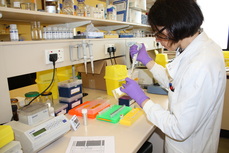Microsatellite analysis

Indication
Microsatellites consist of DNA sequences, each 1 – 6 nucleotides long,
which are repeated many times. The number of repeats is highly variable, making it possible to use microsatellites as markers in genetic tests. Microsatellites are generally found in the non-coding regions of the genome. Individuals typically have two alleles for all microsatellites, one inherited from each parent.
Microsatellite alleles normally differ slightly (i.e., they are heterozygous). If one of a pair of alleles is altered or if there is loss of part or all of a chromosome, then loss of heterozygosity (LOH) occurs. Such LOH of microsatellite alleles on chromosome 3 in uveal melanoma cells indicates an increased risk of metastatic disease.
Methodology
Multiplex PCR based analysis of extracted DNA
Test Parameters
This assay detects LOH of four microsatellites located on chromosome 3p and four microsatellites located on chromosome 3q. The region containing the microsatellite is amplified by PCR using forward and reverse primers that flank the microsatellite. The size of the amplified region can then be determined by the number of repeats present in the microsatellite on that allele. One of each primer pair is fluorescently tagged to allow quantitation by capillary electrophoresis. A comparison of the peak area of tumour DNA (e.g. tumour, and biopsy specimens) and normal DNA (matched blood sample) allows the determination of allele ratio in the tumour.
This is used as an alternative to MLPA when the DNA yield from the tumour specimen is less than 20ng/µl.
Sample Requirements
Fresh biopsy, frozen or formalin fixed paraffin embedded uveal melanoma material together with a matched whole blood sample (100-500µl). MGG stained cytospin or other histological slide or copy of the corresponding pathology report. This procedure requires at least 20ng DNA.
Contact
We are happy to process samples from external centres for MSA, please email mailto:[email protected] for further information, or call: (+44) 0151 794 9117.
MSA Publications
Effects of plaque brachytherapy and proton beam radiotherapy on prognostic testing: a comparison of uveal melanoma genotyped by microsatellite analysis.
Thornton S, Coupland SE, Heimann H, Hussain R, Groenewald C, Kacperek A, Damato B, Taktak A, Eleuteri A, Kalirai H. Br J Ophthalmol. 2020 Feb 5. pii: bjophthalmol-2019-315363. doi: 10.1136/bjophthalmol-2019-315363.
Concordant chromosome 3 results in paired choroidal melanoma biopsies and subsequent tumour resection specimens.
Coupland SE, Kalirai H, Ho V, Thornton S, Damato BE, Heimann H.
Br J Ophthalmol. 2015 Jul 23. pii: bjophthalmol-2015-307057. doi: 10.1136/bjophthalmol-2015-307057. [Epub ahead of print]
Microsatellites consist of DNA sequences, each 1 – 6 nucleotides long,
which are repeated many times. The number of repeats is highly variable, making it possible to use microsatellites as markers in genetic tests. Microsatellites are generally found in the non-coding regions of the genome. Individuals typically have two alleles for all microsatellites, one inherited from each parent.
Microsatellite alleles normally differ slightly (i.e., they are heterozygous). If one of a pair of alleles is altered or if there is loss of part or all of a chromosome, then loss of heterozygosity (LOH) occurs. Such LOH of microsatellite alleles on chromosome 3 in uveal melanoma cells indicates an increased risk of metastatic disease.
Methodology
Multiplex PCR based analysis of extracted DNA
Test Parameters
This assay detects LOH of four microsatellites located on chromosome 3p and four microsatellites located on chromosome 3q. The region containing the microsatellite is amplified by PCR using forward and reverse primers that flank the microsatellite. The size of the amplified region can then be determined by the number of repeats present in the microsatellite on that allele. One of each primer pair is fluorescently tagged to allow quantitation by capillary electrophoresis. A comparison of the peak area of tumour DNA (e.g. tumour, and biopsy specimens) and normal DNA (matched blood sample) allows the determination of allele ratio in the tumour.
This is used as an alternative to MLPA when the DNA yield from the tumour specimen is less than 20ng/µl.
Sample Requirements
Fresh biopsy, frozen or formalin fixed paraffin embedded uveal melanoma material together with a matched whole blood sample (100-500µl). MGG stained cytospin or other histological slide or copy of the corresponding pathology report. This procedure requires at least 20ng DNA.
Contact
We are happy to process samples from external centres for MSA, please email mailto:[email protected] for further information, or call: (+44) 0151 794 9117.
MSA Publications
Effects of plaque brachytherapy and proton beam radiotherapy on prognostic testing: a comparison of uveal melanoma genotyped by microsatellite analysis.
Thornton S, Coupland SE, Heimann H, Hussain R, Groenewald C, Kacperek A, Damato B, Taktak A, Eleuteri A, Kalirai H. Br J Ophthalmol. 2020 Feb 5. pii: bjophthalmol-2019-315363. doi: 10.1136/bjophthalmol-2019-315363.
Concordant chromosome 3 results in paired choroidal melanoma biopsies and subsequent tumour resection specimens.
Coupland SE, Kalirai H, Ho V, Thornton S, Damato BE, Heimann H.
Br J Ophthalmol. 2015 Jul 23. pii: bjophthalmol-2015-307057. doi: 10.1136/bjophthalmol-2015-307057. [Epub ahead of print]

